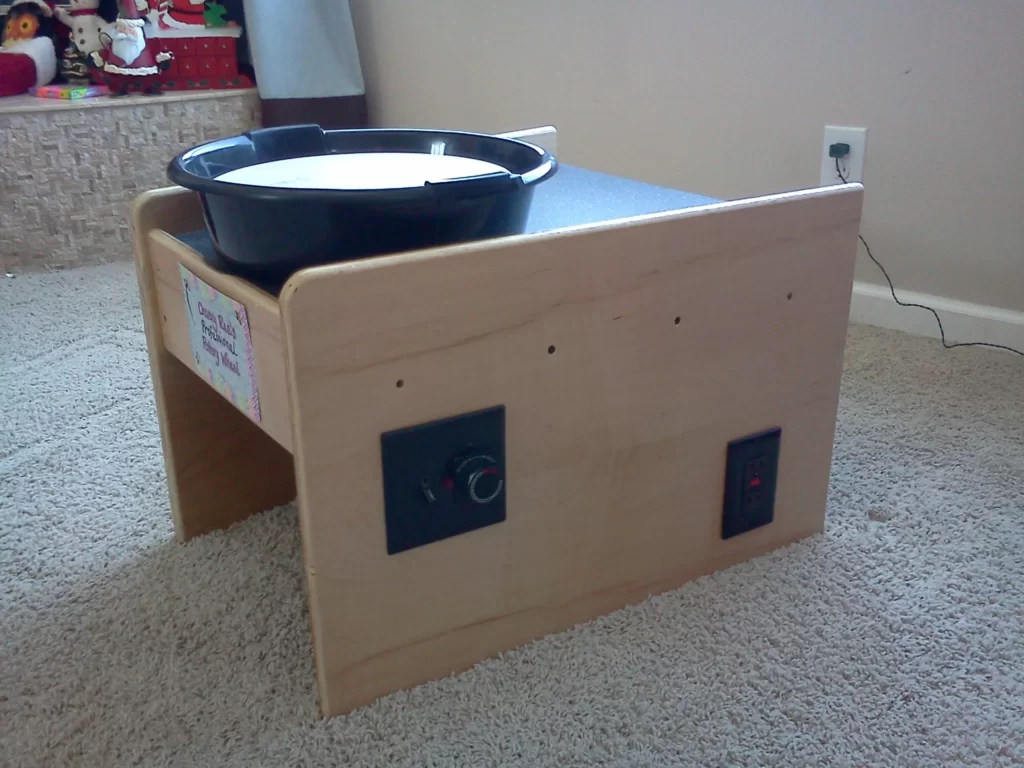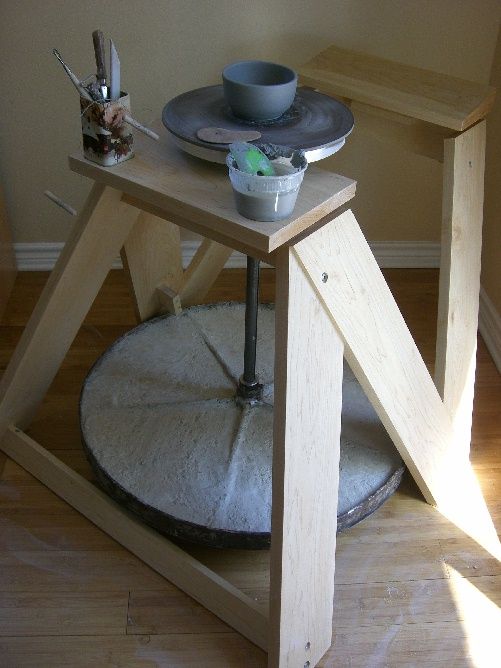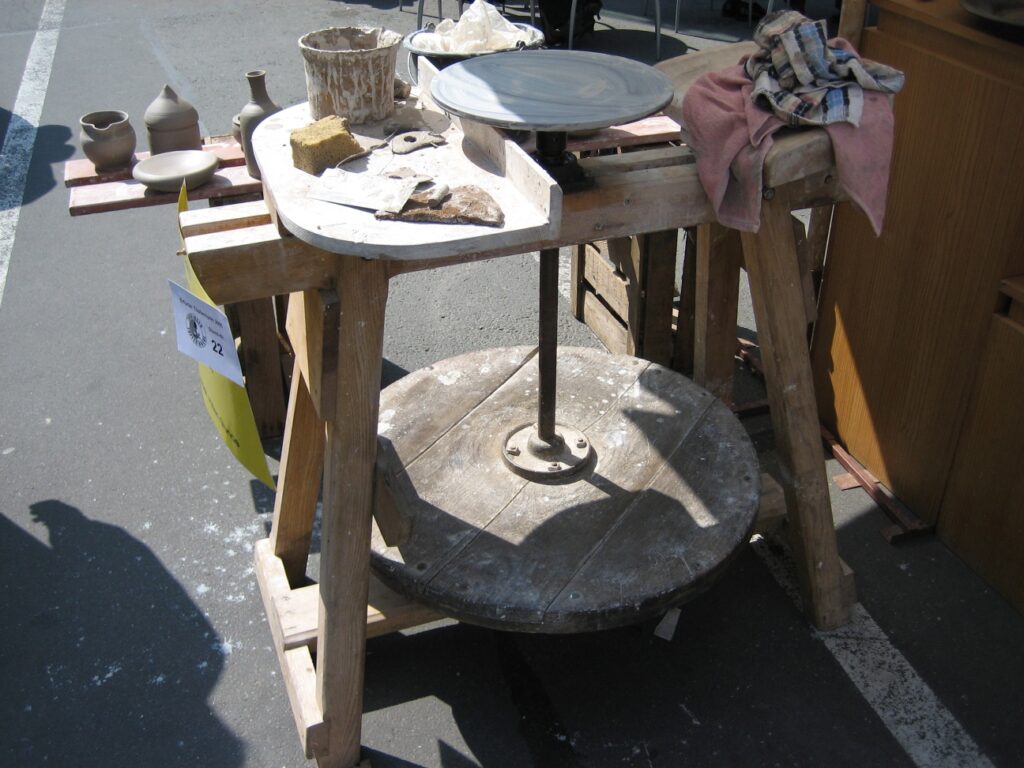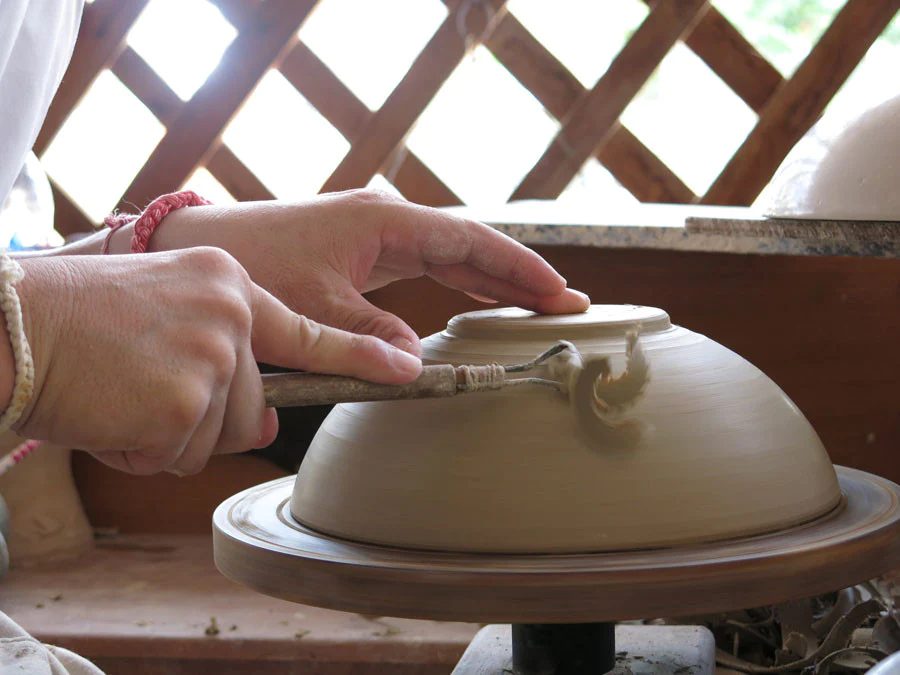How to make a pottery wheel
The pottery wheel is considered one of the best revolutionary human inventions. It might sound like something very funny in the modern world, but the pottery wheel was so effective and useful that it led to major changes in human civilization.
Some might say agriculture production would not take the turn it has taken in history without the pottery wheel. But enough about the bygone days; even today, the pottery wheel is an essential piece of equipment for most pottery makers. Numerous kinds of pottery require pottery wheels for their perfect creation.
As a beginner, you will require a fair amount of time to master the pottery wheel. That being the case, starting as soon as possible is a good idea. Buying pottery wheels can cause quite a strain on your pocket since good-quality wheels can be a bit expensive.
The good news is you can make one yourself, and even with the materials purchased, it will not cost you more than $30 to $50. Therefore, making a good quality pottery wheel if you already have the materials is basically free.
Making a pottery wheel
A DIY pottery wheel is easy to make and will take at most 1 or 2 days. Let us look at how you can create the perfect pottery wheel for all your subsequent projects.
Materials required for making a pottery wheel
You will need some materials and tools to make the perfect pottery wheel. These materials will be any existing wheel or a360 degree mop bucket, strong adhesive like hot glue or polyurethane glue, and plastic pots of a small circumference that will raise the height of your wheel.
A very important thing to remember is that all these materials should have a stable base and top surface. Otherwise, your wheel will be useless since an unstable base will only cause more problems.

Where to start?
A mop bucket, a wheel, or a metallic flat surface plate can be just the perfect pottery wheel for beginners. Place it on top of a stable pot with just the perfect circumference, which can raise the level of your wheel while keeping it rotatable.
Glue everything in place. This is the most important step in the whole process, and your setup needs to be uniform and stable to work properly. You also need to give it enough time to dry out and test whether the other ship is coming off when you actually put it to use.
Remember there are two kinds of pottery wheels
There are two kinds of pottery wheels that you can make in today’s day and age. One is the time-tested manual pottery wheel which has seen the change of millennia. The other is the electric pottery wheel which further simplifies the task and makes making pottery a very fast business.
To create an electric pottery wheel, you need to connect your set up with a motor of acceptable speed and complete the circuit with a switch and the plug. You can choose to use simple uniform plywood for the base.
What wheels will it be a good idea to use?
You will be surprised to know that many experienced pottery makers use the most unthinkable equipment as their pottery wheel. Some very common DIY pottery wheel equipment include the ceiling fan, the car wheel, the scooter wheel, and the bike frame.
The kick pottery wheel is the easiest one to make and the one that is best for beginners since you can operate it on various speed limits without any technical complexity in its construction. The kick pottery wheel is manual, and the construction and the operation are super easy.

Is it possible to make tabletop pottery wheel pans?
Tabletop pottery wheel pans are one of the most popular pottery wheel options for beginners and advanced students in the modern world. It is safe for children and can be placed on any random table and operated from a nearby area.
This means you can sit indoors in the comfort of your own home and learn pottery. Tabletop pottery can be operated using a simple circuit or power bank, as is most suitable for the user.
Things to remember while building a pottery wheel
Guidelines of what should be done are great, and a list of what not to do is even better. When you are about to undertake a new project, it is a good idea to keep in mind the overall object and how you can theoretically make your project better.
While working on it, you will find that the same theoretical knowledge comes back to help you at just the right moment.
The correct size of your wheel
The most practical consideration when making a pottery wheel is how big of a space you have for its accommodation. Pottery wheel can be made of any size and shape you want. The light ones are best for beginners who do not have a workshop or simply cannot think of a pottery wheel that is so hard to store.
If you have an open area in your backyard, you can use that place to practice pottery. In that case, you can use a larger wheel. However, using an open area means subjecting yourself and your work to environmental factors like a strong wind, rain, and dust.
Do you need a portable one?
Many of us require a portable pottery wheel. Especially if you do not have a designated area for your pottery workshop or simply need to bring your wheel to class, a huge pottery wheel that cannot be carried from place to place will not work.
Portable pottery wheels are created differently, and you can operate them using a battery or a power bank. You want a pottery wheel that will fit in easily with your everyday lifestyle and preferences.
How heavy is your pottery wheel?
This is quite similar to the points made above. Your pottery wheel’s resultant setup must be light enough to carry it around. You will need to modify your pottery wheel once you have begun working on it. A very heavy pottery wheel will make such additions quite difficult.
You can reduce the weight of your pottery wheel by using lighter materials. You should also try to use a lightweight base and stand for your wheel. Things like car wheels should be avoided in this case.
Would it be a clever choice to get a free-standing wheel?
What difference can be between a tabletop wheel and a free-standing wheel? Which one would suit your requirements better? Every standing wheel stands on 3 legs of its own. However, sitting around them is easier, and you get better access to the pottery.
A freewheel is for you if you want to make unusual asymmetrical patterns and try advanced skills. You can even adjust the height of your wheel when it is free-standing. A free-standing wheel will not be portable.
How uniform does the surface feel?
You will basically combine basic laws of natural physics to help you create symmetrically and uniformly finished pottery in much less time. All you need to remember is to trust the process.
However, if the surface is tilted or the rotation is jerky, the result will be very unsatisfactory when you sit down to create. Therefore, ensuring the pottery wheel you’re creating is uniform in both surface and rotation is essential.
Are you left-handed?
Most ready-made pottery wheels have a switch that can change the direction in which the wheel moves. Usually, right-handed porters want the way to turn counter-clockwise, whereas if you are left-handed, you will work better with a wheel moving clockwise.
Sometimes, you will like to change the wheel’s direction alternatively when working with complex projects. For example, most right-handed quarterly makers trim their pots on a clockwise moving wheel.
Speed versus power
Regarding pottery wheels, speed is one thing, and power is another. Speed simply refers to the velocity at which your wheel is rotating. As a beginner, you want to work at various speeds to understand how that influences the creation of pottery.
In more advanced settings, it doesn’t really matter if your wheel is spinning at 230 or 250 rpm. Power is how much pressure your wheel can withstand while being in motion. Find out how powerful your motor is. Power in the case of a pottery wheel refers to torque.
The more the torque, the better you can withstand pressure.
Can you operate an electric pottery wheel?
An electric pottery wheel has a certain rate you want it to move. Using an electric pottery wheel as a beginner is difficult to master. Also, this means you will never learn how to use manual pottery. Manual pottery speeds can be operated at any level. This way, you get to sharpen your understanding of the process. Manual pottery wheels can be operated by hand or by feet.
Hand pottery wheels usually rely on some sort of lever or toggle. For food-operated pottery wheels, you can use a foot pedal or lever. You can even buy one from the market and incorporate it into your craft.
Centering capacity
The centering capacity is something that any equipment with a circular base must have. This refers to how much clay your wheel can hold in its center and allow you to manipulate. If you are working with small cups, bowls, and plates, you want to make a pottery wheel that is ½ hp. But for more advanced and larger projects, you have to go with a hp of ¾ or more.
If you use large amounts of clay on a wheel not designed for large projects, its speed will slow down because of the weight applied.
However, the centering capacity depends heavily on how much physical strength you are throwing and what shape you mold your clay into after wedging it. You can turn a small pottery wheel into a tool and work wonders with the right techniques.

What kind of clay should you use for your pottery wheel?
One question still remains unsolved. What kind of clay can you use on your pottery wheel, and what kind of pottery will you end up making? As a beginner, we might underestimate the materials used in pottery. But in truth, the kind of clay you use matters the most. There are four types of clay that you can use while making pottery with a pottery wheel. to know more about storing your clay safely read our guide on clay preservation.
Porcelain clay
Porcelain clay is also known as China ceramic. It is quite commonly used to make pottery that resembles ceramics. Good quality porcelain clay is ceramic and nothing else. It is the most beautiful kind of pottery but, at the same time, the toughest to work with.
Potter also needs to mix in other materials with this clay for it to last.
Earthenware clay
General pottery wheels work best with this kind of clay. It has the lowest firing temperature. It is the most time-tested of clays and has been used since the dawn of human civilization. Before firing, it has a usual orange, grey-brown, or red color. It is a fairly plastic clay and can be mastered easily by beginners.
Ball clay
Ball clay also works wonders on the pottery wheel. However, you might need to mix it with some other kinds of places to increase its production value. This clay is a bit harder to use. It is grey before firing and afterward turns white. It is one of the widely used clays by professional potters.
Stoneware clay
A beautiful clay with astonishing finishing, it is known for its stone-like qualities. It is non-porous plastic and hard. This clay is used for making decorative items and tableware. If you are into interesting choices when it comes to craft, you will love this option.
Conclusion
A life-changing experience for most students. It is an interesting and exciting activity that, once learned, never leaves you. Pick the correct materials for making the best pottery wheel since the pottery you use will heavily influence the skills you learn and how well you get at your craft.

FAQs
Can I make a pottery wheel out of a mop bucket?
You can place a pottery wheel inside a mop bucket and create a homemade pottery wheel which will also be portable.
Will I be able to do large projects on portable pottery wheels?
Portable pottery wheels can be created for large projects. However, this pottery wheel will not be as small and lightweight as the others.
Is a portable pottery wheel durable?
How long a pottery wheel last depends on how carefully you use it and what materials you choose to make it with. Therefore, a portable pottery wheel is just as durable as a free-standing wheel.

Being associated with art and craft field since decades as a hobbyist and life long learner has given me an opportunity to learn many new things related to art, craft, paints and pottery which i am trying to share with your guys on this website. I have expertise of being professional painter and potter for the last 20+ years
I have learned mind blowing cool tips and insights which makes me a person with ability to improvise and come up with creative ideas and solutions to make stunning and impeccable art pieces of all types which are adored by people across the globe on this website and other platform.


